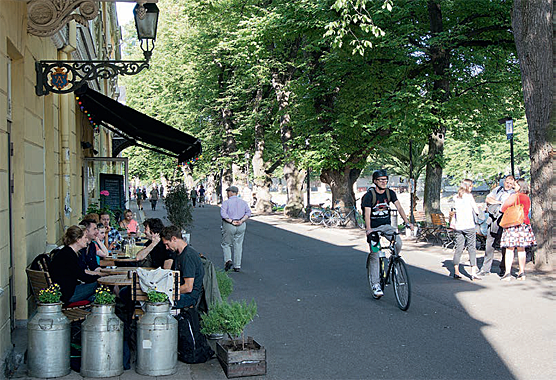
© Arto Takala / City of Turku
The City of Turku aims to be carbon neutral by 2029. The Blue-Green Factor is one of the many measures used in the city’s award-winning climate work to assess the climate sustainability of yard areas. The Canemure subproject in Turku promotes the systematic use of the Blue-Green Factor in urban construction.
The words ‘lush, comfortable and sustainable’ encapsulate the goal of urban planning in terms of both private yards and public urban spaces. In zoning, this translates to a high-quality Green Factor. Turku works towards its goal by including the Blue-Green Factor in the standard steps of urban planning and construction. The goal is also written in the city strategy’s climate plan and the city’s stormwater programme.
Blue-Green Factor as a method
The Blue-Green Factor is a tool for designing yard areas. The factor measures the volume and type of vegetation in the yards and the delay in the flow of stormwaters resulting from vegetation, surfaces and potential stormwater structures. In practice, the factor is a three-part spreadsheet filled in by the yard designer. The factor was developed in the iWater project for the Union of the Baltic Cities (UBC). Now, the tool has been handed over to the Canemure subproject for climate-sustainable urban planning in Turku. The project trains, supports and develops the use of the factor to make it an established part of basic zoning, building inspection and spatial services work.
Most Finnish cities have their own Green-Blue Factors. They follow the same principles but differ slightly. Helsinki and Vantaa have the longest history with the factors in Finland, whereas internationally, Berlin, Malmö and Seattle are particularly known for their use of the factors.
Stormwater, climate change and quality of urban space as challenges
Large cities are now struggling to manage their stormwater. Large cities primarily grow inward as a result of infill construction. This is a positive option for the energy efficiency of the urban structure. However, it increases the surface runoff of stormwater as the volume of impervious surface increases, preventing the water from getting absorbed, evaporated or retained as in less constructed areas.
Climate change is changing precipitation and increasing extreme weather phenomena; high spikes of downpour are becoming more common and cities get more rain than snow in the winter. Downpour, in particular, may exceed the capacity of the stormwater drainage system, creating stormwater floods that may damage structures and injure people. That is why more measures are needed to increase green and permeable surface areas in cities. The Blue-Green Factor is a plot-level tool for this problem.
In addition to delaying stormwater, green urban areas promote adaptation to climate change by bringing balance to microclimates, in other words heat, wind and humidity, and by supporting the diversity of vegetation. Large trees, in particular, also absorb carbon dioxide.
However, it is also extremely important to develop a lush, high-quality, comfortable and aesthetically pleasing city in both plots and public areas. The Canemure project will also attempt to introduce the regional factor model, developed in Stockholm, to public areas as a further development option of the Blue-Green Factor.
Author: Project Manager Kristina Karppi, Canemure subproject of the City of Turku, Urban Design and Land Property, City of Turku
The article was published in the Hiilineutraali Suomi journal in September 2020 (in Finnish).
Read more